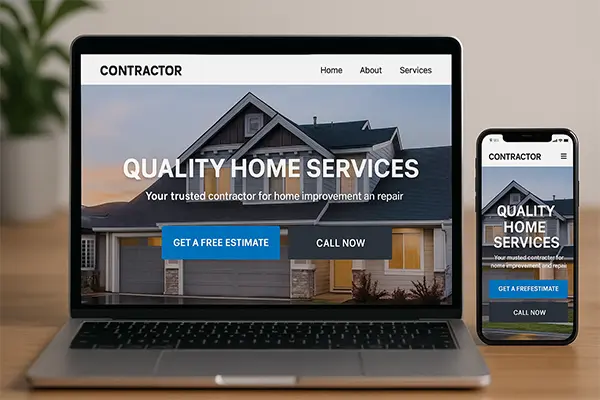
If you’re a contractor or home service business owner, you might be wondering:
“Why aren’t more of my website visitors turning into leads?”
You’ve got the traffic. Your services are solid. But your phone isn’t ringing nearly as much as it should be.
The answer? You’re probably missing one of the most critical elements of your site:
a strong, clear, and strategically placed call-to-action (CTA).
In this post, we’ll walk through why calls to action on your website matter, what makes a CTA effective, and where to place them to drive conversions. If you're not sure your site is doing this well, it might be time to upgrade your website design with professional help to start capturing more leads.
What Is a Call-to-Action?
A call-to-action (CTA) is a prompt that encourages your visitors to take the next step—whether it’s calling your office, filling out a contact form, booking a service, or requesting a quote.
Think of CTAs as guideposts on the user journey. Without them, your visitors won’t know what to do next.
Examples of common CTAs:
-
“Get a Free Quote”
-
“Schedule Your Estimate”
-
“Call Now”
-
“Book Online”
-
“Request a Callback”
Each one is designed to get users to take action, which is exactly what you want.
Why CTAs Are Crucial for Service Area Businesses
Your website isn’t just a digital brochure—it’s a lead generation machine.
Without compelling calls to action on your website, you’re relying on users to figure out what to do next on their own. Spoiler alert: most won’t.
Here’s why CTAs are non-negotiable:
1. They Guide Visitors Toward a Goal
Your visitors are busy. A clear CTA removes confusion and tells them exactly what to do next.
2. They Improve Website Conversions
Every click, call, or form submission begins with a strong CTA. Adding or improving your CTAs can dramatically increase your conversion rate.
3. They Make Your Website Work for You
Your website should be your hardest-working sales tool—24/7, even when you’re on a job site. CTAs help make that happen.
What Makes a Call-to-Action Effective?
Not all CTAs are created equal. The ones that actually generate leads tend to follow a few key principles:
✅ Clear and Simple Language
Use short, action-oriented phrases. Avoid vague wording like “Submit” or “Click Here.” Instead, say:
-
“Get Your Free Estimate”
-
“Book a Service Today”
-
“Call for Fast Repairs”
✅ Prominent Placement
Make sure CTAs are:
-
Above the fold (visible without scrolling)
-
At the end of each service section
-
In sticky headers or sidebars (especially on mobile)
✅ Designed to Stand Out
Use buttons with contrasting colors, bold text, or visual icons. They should look clickable and draw the eye.
✅ Specific to the Page Content
Tailor the CTA to match the content. A CTA on your deck repair page should say “Request Deck Repair Quote”—not something generic like “Contact Us.”
Where Should CTAs Be Placed?
Location matters. Strategic CTA placement ensures users never have to guess what to do next.
Here’s where they should appear:
🔹 On the Homepage
Include a bold CTA above the fold and another mid-page. Your homepage is prime real estate for converting visitors.
🔹 On Every Service Page
Don’t just describe your service—invite the visitor to take action immediately. Add CTAs throughout, not just at the bottom.
🔹 In the Navigation or Header
A sticky “Call Now” or “Book Online” button keeps your CTA in sight as users scroll.
🔹 In Blog Posts
Even informational content can be a conversion tool. For example, a post about “How to Spot a Roof Leak” should include a CTA like:
“Think you’ve got a leak? Schedule a Roof Inspection Today.”
Common CTA Mistakes to Avoid
If you already have calls to action on your website, but they’re not working, you might be falling into one of these traps:
-
❌ Too Many CTAs Competing for Attention
Confuse your users and they’ll do nothing. Stick to one primary CTA per section. -
❌ Bland or Generic Wording
“Submit” doesn’t tell anyone what they’re getting. Be clear and benefit-driven. -
❌ Poor Mobile Design
Your mobile visitors need large, thumb-friendly buttons that load fast and are easy to click. -
❌ Broken or Slow Forms
Nothing kills conversions like a form that doesn’t work. Test yours regularly.
How Calls-to-Action Help Convert Traffic Into Revenue
Let’s put it simply: traffic without action = wasted opportunity.
You could be running ads, ranking on Google, or getting referrals… but without a well-placed CTA, all that effort may lead nowhere.
Adding or improving the calls to action on your website can be one of the fastest, easiest ways to boost your lead flow. Especially when paired with conversion-focused design and local SEO, your site can become a true sales tool for your contracting business.
Want help putting this into action? Our web design and SEO services are built specifically for service area businesses like yours.
Final Thoughts
If your website isn’t converting visitors into customers, it’s not doing its job.
Well-crafted, strategic calls to action on your website can completely change that.
They tell visitors exactly what to do, guide them through the buying journey, and ultimately bring more revenue to your business—all without extra effort once they’re in place.
Ready to turn your website into a lead-generating machine?
Let’s talk about how we can help.

